
Like many of you, I’ve spent a lot of time at home since March 16. To combat the impending doom of boredom, one thing helping me is creating art. Something about giving life (and color) to an idea in my head is highly motivating and also a relaxing way to spend my free time. I won't lie, sometimes it takes multiple tries and variations for me to be content with my creation; but that’s one of the best parts of making art, right?! The process. So with that said, I offer you a bit of insight and instruction on a fairly simple art craft that hopefully you can try at home, too.
A Bit of History
I’m sure people have been using stencils to paint things for hundreds (thousands?) of years, opens a new window, but what I'll focus on in this blog are stencils used in graffiti culture and the street art, opens a new window scene. Spray painted stencils were originally used in protest art as early as the 1960s. French artist Ernest Pignon-Ernest, opens a new window is credited as one of the first artists to use this technique and adapt it to street art during the 1970s. Pignon-Ernest used simple monochromatic spray-painted stencils, opens a new window to portray the grim realities of war and to bring important social issues to light. Although Pignon-Ernest never earned worldwide recognition, he definitely left his mark all over Europe.
Fast forward about 10 years and another French artist by the name of Blek le Rat, opens a new window began to really put stencil street art on the map (and by “map”, I mean on walls all over the streets of Paris). Like his French predecessor, Blek’s stencil art focused on political and social commentary, often including his signature motif of a rat, opens a new window along with other imagery. During this time (the early/mid-1980s), graffiti and street art were becoming an art movement practiced all around the world - from Paris, to New York, to Los Angeles, to even the streets of Bristol, England.
As artists like Shepard Fairey, opens a new window, Nick Walker, opens a new window, FAILE, opens a new window, and Vhils, opens a new window began to incorporate the use of stencils with their street art throughout the 1990s and 2000s, none became more notable than (to this day) the anonymous artist known as Banksy, opens a new window. Banksy began painting graffiti in his hometown of Bristol in the early 1990s. As with Pignon-Ernest and Blek le Rat, Banksy’s stencil street art is best known for its politically driven visuals, opens a new window and social content, opens a new window. He's done it all - from hosting an unauthorized month-long residency in the streets of NYC, opens a new window, to opening his own functioning theme park, opens a new window. Banksy has become a household name and quite possibly the most prolific street artist of this generation. And to think it all started with an idea in his head and a stencil he cut out himself.
How to Do It Yourself
So now it’s your turn! Below is a simple how-to guide on making stencils at home. Whether you want to spray paint something on your skateboard or you’re looking for a fun activity to do with your family, let’s get creative.
Start with a few must needed supplies: a can of spray paint, an X-Acto knife, card stock paper (or any type of thick paper), scotch tape, a self-healing cutting mat (or thick cardboard you can cut into), and your design.
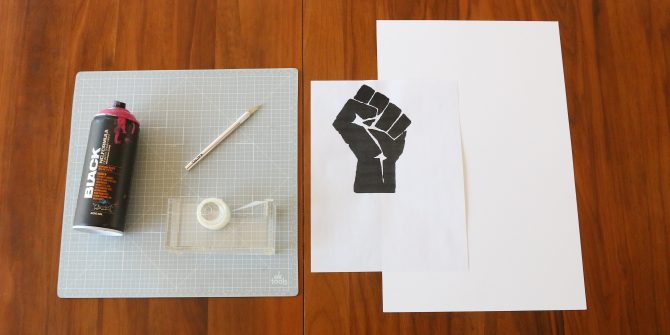
A few things that are not must-needs but would be helpful: disposable gloves, a garbage bag, and painter's tape.
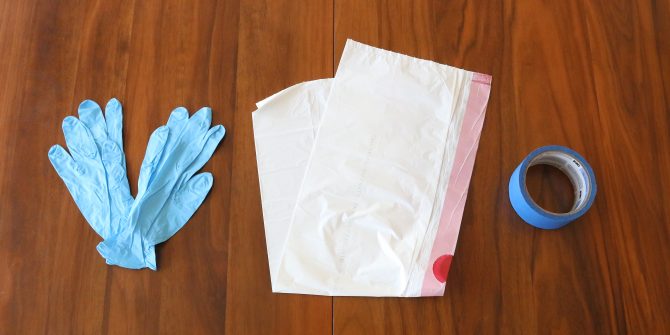 Step 1: Find your stencil design. Google, opens a new window is your best friend here. Search “________ stencil” and you most likely will find something that works. Letter stencils are great (and fairly easy to cut), or you can try to search something like “fist stencil” which is what I did for my example below.
Step 1: Find your stencil design. Google, opens a new window is your best friend here. Search “________ stencil” and you most likely will find something that works. Letter stencils are great (and fairly easy to cut), or you can try to search something like “fist stencil” which is what I did for my example below.
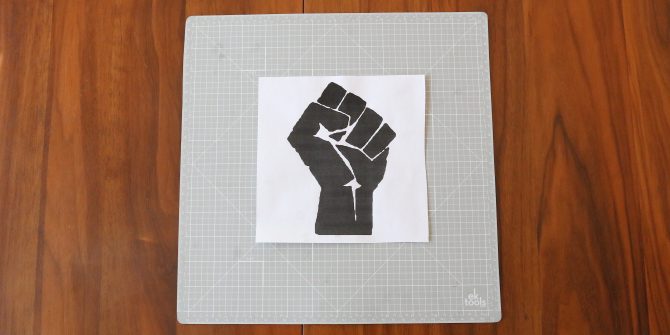 Step 2: Print the design and use small pieces of scotch tape to tape it to the center of your card stock paper (or whatever thick paper you’re using for your stencil).
Step 2: Print the design and use small pieces of scotch tape to tape it to the center of your card stock paper (or whatever thick paper you’re using for your stencil).
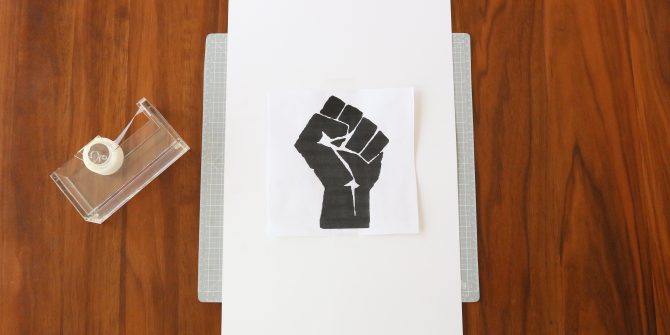 Step 3: With your self-healing cutting mat (or thick piece of cardboard) underneath, carefully trace around all of the black area with your X-Acto knife.
Step 3: With your self-healing cutting mat (or thick piece of cardboard) underneath, carefully trace around all of the black area with your X-Acto knife.
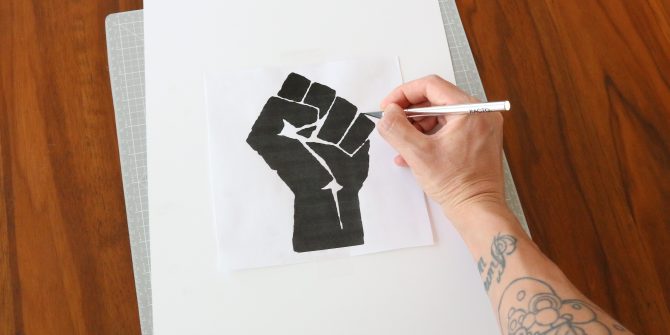 Step 4: Peel off the loose pieces as you go so you know what is already cut. Remember, you want plenty of negative space, opens a new window when cutting out stencils.
Step 4: Peel off the loose pieces as you go so you know what is already cut. Remember, you want plenty of negative space, opens a new window when cutting out stencils.
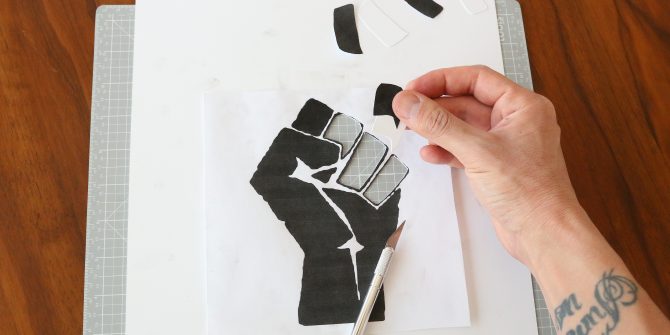 Step 5: You don’t need to be super accurate with your cutting, so no worries if you make a mistake (use the scotch tape to reconnect two pieces if you have to). You also don’t need to cut everything from the design you printed out - this is a great time to customize the design and tweak the image so you can make it your own.
Step 5: You don’t need to be super accurate with your cutting, so no worries if you make a mistake (use the scotch tape to reconnect two pieces if you have to). You also don’t need to cut everything from the design you printed out - this is a great time to customize the design and tweak the image so you can make it your own.
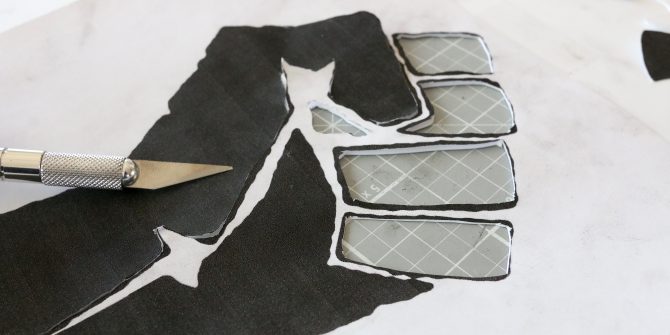 Step 6: When you've finished cutting, carefully peel off the pieces of scotch tape from your stencil, and boom - you have a freshly cut stencil ready to use!
Step 6: When you've finished cutting, carefully peel off the pieces of scotch tape from your stencil, and boom - you have a freshly cut stencil ready to use!
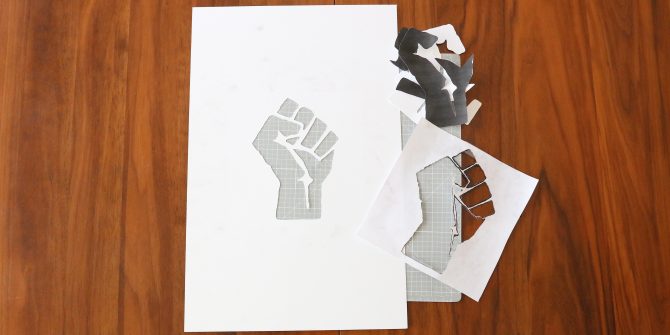 Step 7: Be mindful where you put your stencil before spraying it. A good idea is to tape a garbage bag underneath your work area so that spray paint doesn’t get all over. If you have painter's tape, use a few pieces to secure the stencil on the object you are spray painting so that the stencil doesn’t move around. And lastly, if you have disposable gloves, use them so the paint doesn’t get all over your hands either.
Step 7: Be mindful where you put your stencil before spraying it. A good idea is to tape a garbage bag underneath your work area so that spray paint doesn’t get all over. If you have painter's tape, use a few pieces to secure the stencil on the object you are spray painting so that the stencil doesn’t move around. And lastly, if you have disposable gloves, use them so the paint doesn’t get all over your hands either.
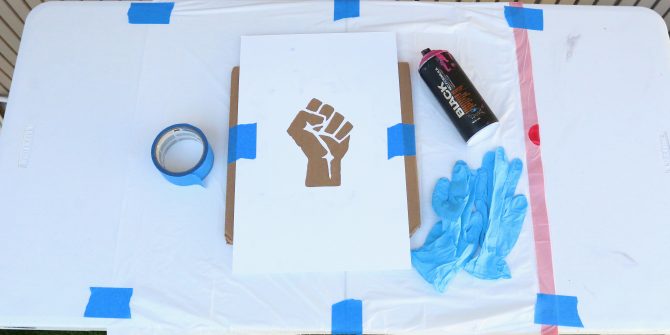 Step 8: When using spray paint, aim the can at an angle (instead of holding it directly above your stencil) at about 6 inches away, and keep your hand in motion while spraying. You want to make sure the spray is evenly distributed and that paint isn’t getting too dense in one area - the more you spray, the more detail you might lose.
Step 8: When using spray paint, aim the can at an angle (instead of holding it directly above your stencil) at about 6 inches away, and keep your hand in motion while spraying. You want to make sure the spray is evenly distributed and that paint isn’t getting too dense in one area - the more you spray, the more detail you might lose.
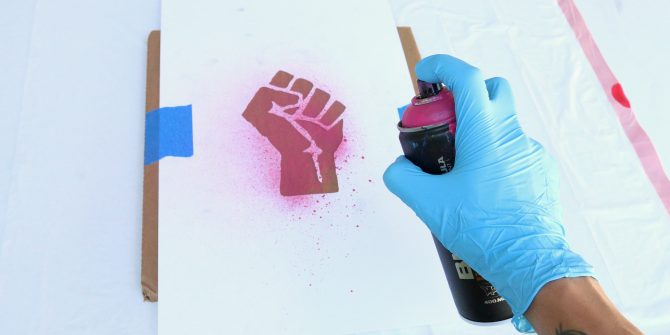 Additional pro tips: Always spray paint outdoors. After you spray, allow it to dry for a minute before you carefully peel off the stencil. Depending on how thick your paper is, you should be able to use the stencil a few times before it gets too wet from the spray paint and starts to deteriorate. And maybe most importantly, remember we are all artists.
Additional pro tips: Always spray paint outdoors. After you spray, allow it to dry for a minute before you carefully peel off the stencil. Depending on how thick your paper is, you should be able to use the stencil a few times before it gets too wet from the spray paint and starts to deteriorate. And maybe most importantly, remember we are all artists.
Want to Learn More?
Here are some books and movies on stencil street art you can check out:
You Are An Acceptable Level of Threat and If You Weren't You Would Know About It
What would you make a stencil of? Let us know in the comments below!


Add a comment to: DIY Stencil Spray Paint Art